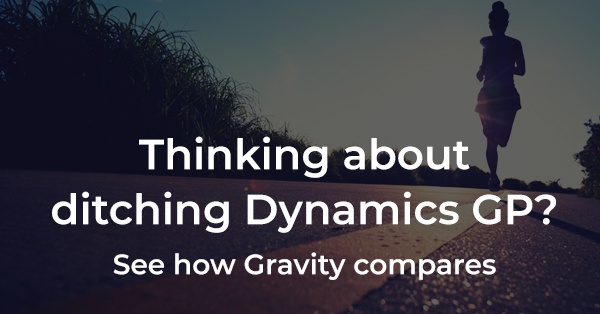Switch from Dynamics GP to cloud accounting for multiple businesses

If you’re using Microsoft Dynamics GP (formerly Great Plains) for your multi-entity business, you may have already encountered limitations that are holding back your growth.
While Microsoft continues to support Dynamics GP until at least 2028, there are many reasons why businesses are making the switch to cloud-based accounting solutions like Gravity Software. Here’s why transitioning to a cloud-based solution could be a game-changer for your company.
Why move from Microsoft Dynamics GP?
For years, Microsoft Dynamics 365 Business Central was a common alternative for users looking to upgrade their accounting system. However, Business Central shares many of the same flaws as Dynamics GP, especially when it comes to managing multi-entity accounting. It lacks true multi-entity functionality, meaning you still need to log in and out of separate databases to manage transactions and generate reports. This process is not only time-consuming but increases the risk of errors.
The platform that Business Central is built on dates back to 1987, making it outdated for modern business needs. For example, managing cash flow across multiple companies in Business Central is a manual process, which creates inefficiency and delays.
Gravity Software: A better alternative
Fortunately, Gravity Software offers a modern, cloud-based accounting solution built on the Microsoft Power Platform. This means you get the same security and familiarity you expect from Microsoft, but with enhanced functionality designed specifically for multi-entity accounting.
With Gravity Software, you can manage all your companies in one database using a shared chart of accounts, eliminating redundant data entry. You can easily generate consolidated financial reports across all entities and export them to Excel with just one click.
If you’re already using Office 365, Gravity integrates seamlessly with your existing tools, allowing you to log in with the same credentials and work in a unified system across Microsoft Teams, Outlook, and other Microsoft apps.
Top 5 reasons to switch from Dynamics GP to Gravity
1. Limited cloud functionality with Dynamics GP
While Dynamics GP can be hosted on Microsoft Azure, it’s not a true cloud-based solution. You still need additional applications like Remote Access to work with the system, adding complexity and additional costs. In contrast, Gravity Software provides a fully cloud-based solution that’s accessible from anywhere, with automatic updates and no reliance on external hosting.
2. Simplify multi-entity accounting with Gravity
One of the most significant challenges with Dynamics GP is managing multi-entity operations. In GP, you have to log in and out of separate databases to handle transactions and generate reports, which wastes time and increases the chance of errors. Gravity Software allows you to manage multiple entities in a single, shared database, streamlining your accounting processes and generating consolidated reports with ease.
3. Avoid expensive upgrades and maintenance
Upgrading Dynamics GP often involves expensive hardware, IT support, and consulting services. These costs can add up quickly, and scaling the system for additional users or entities requires significant infrastructure investment. With Gravity Software, there are no infrastructure costs, as the software is cloud-based, and updates are automatic, saving you money and time.
4. Streamlined reporting and workflow automation
Reporting in Dynamics GP can be cumbersome, especially when it involves consolidating data across multiple entities. Gravity Software simplifies reporting by offering real-time, automated reports that can be easily customized. Additionally, Gravity’s workflow automation features reduce the need for manual data entry and approval processes, further improving efficiency and accuracy.
5. Seamless integration with Microsoft Tools
If you’re already using Microsoft tools like Office 365, you’ll appreciate how Gravity Software integrates seamlessly with them. You can access Gravity using the same login you use for Outlook, Teams, and Microsoft CRM, allowing your team to work more efficiently and with fewer disruptions.
What customers are saying
“Before switching to Gravity Software, our reporting was extremely time-consuming, and we struggled with outdated technology. Gravity has streamlined our financial processes, offering real-time, customizable reporting and the flexibility of cloud access. The transition has saved us both time and money, and now we have the insights we need to make better financial decisions. Gravity has transformed our accounting.”
– Ed Porter, Accounting Manager, Weight Watchers of Maine
For more on how Gravity Software helped Weight Watchers of Maine, read their full success story: Weight Watchers of Maine Case Study
Is it time to make the switch?
If you’re facing high costs, complex workflows, or limitations with Microsoft Dynamics GP, it’s time to consider a better solution. Gravity Software offers a modern, scalable, and cost-effective alternative that’s built specifically for multi-entity businesses.
See how Gravity Software can streamline your accounting processes, save you time and money, and help you manage your entire business with ease. Schedule a demo today and take the first step toward a better accounting system.
Gravity Software
Better. Smarter. Accounting.


